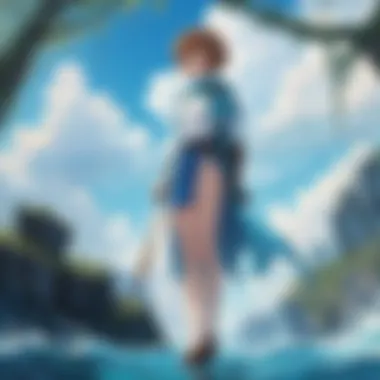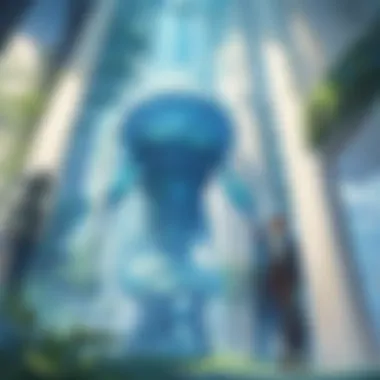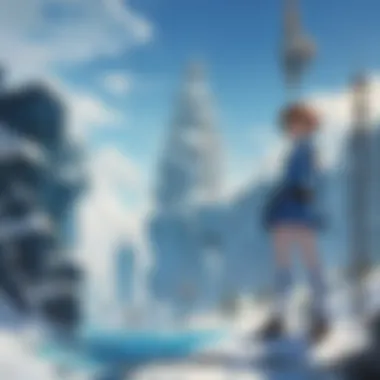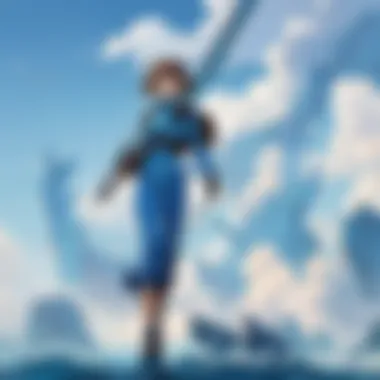Nausicaa: An In-Depth Look at Miyazaki's Themes


Intro
Hayao Miyazaki's Nausicaa of the Valley of the Wind stands as a monumental work in the realm of anime. Released first as a manga and later adapted into an animated film, it combines thought-provoking themes with a richly constructed world. This analysis delves into the layers of storytelling, character development and the underlying philosophical inquiries that resonate throughout the narrative.
The significance of Miyazaki's work transcends mere entertainment. It addresses pressing issues such as environmental destruction and the consequences of technological advancement. As anime continues to evolve, the influence of Nausicaa remains palpable.
This article will dissect the world-building Miyazaki accomplishes and shed light on how themes such as pacifism and environmentalism remain relevant today. By examining these threads, we can appreciate how Nausicaa articulates critical societal reflections, empowering viewers to contemplate the connections between humanity and nature.
Series Overview
Synopsis and Premise
Set in a post-apocalyptic future, the story follows Nausicaa, a young princess dedicated to her valley's well-being. The world she inhabits is plagued by toxic jungles and giant insects known as Ohmu. These creatures symbolize the conflicts between humanity and nature.
Nausicaa’s journey explores the duality of destruction and nurturance. She acts as a mediator in a world torn apart by war and differing ideologies about the environment.
Notable Characters
Nausicaa is complemented by a range of distinctive characters who contribute to the narrative's depth. Key figures include:
- Kushana: A warrior princess representing militaristic perspectives.
- Yupa: A skilled swordsman and mentor to Nausicaa, emphasizing wisdom and restraint.
- The Ohmu: Not just creatures of terror, but deep symbols of nature’s rage and beauty.
Themes and Motifs
Major Themes Explored
Miyazaki's work unveils complex themes:
- Environmentalism: The narrative emphasizes the necessity of harmony with nature rather than domination.
- Pacifism: Nausicaa's actions illustrate the potential for peace in conflict-ridden settings.
- Human Interconnection: The relationships between characters highlight the intrinsic link between humanity and the world.
Symbolism in Storytelling
Throughout the film, Miyazaki uses symbols to enhance the narrative. For instance, the Ohmu represent the consequences of human neglect, while the toxic jungle serves as a metaphor for humanity's attempts to control nature. These elements force the audience to reflect on their actions and the broader implications of environmental degradation.
Artistic Style and Animation
Visual Aesthetics and Design
Miyazaki's animation stylistically captures the contrasts of the story. Bright colors and sweeping landscapes imbue hope. In contrast, the toxic jungles are darker and foreboding. This duality plays a pivotal role in how audiences perceive the world Nausicaa navigates.
Animation Techniques and Trends
During its time, Nausicaa utilized both traditional hand-drawn animation and innovative techniques to display the vast scale of its world. Notable is the fluidity in the portrayal of the Ohmu and their majestic movements, which makes their presence as awe-inspiring as it is threatening. The artistry of the film set a benchmark within the anime industry, influencing future works and directors alike.
"Nausicaa of the Valley of the Wind remains a benchmark in cinematic storytelling, intertwining artistic vision with narrative depth."
Intro to Nausicaa


Understanding Nausicaa is crucial for those engaged with Hayao Miyazaki’s body of work. This film serves as a central piece that encapsulates many of the themes that reappear throughout Miyazaki's storytelling. The intricate world-building within Nausicaa not only presents a captivating narrative but also reflects pressing societal issues. Thus, dissecting this film aids in appreciating its cultural significance and its role in anime history.
Background of Hayao Miyazaki
Hayao Miyazaki is one of the most influential figures in animation. Born in 1941, he began his career in the 1960s. He co-founded Studio Ghibli, which has produced numerous iconic films. Miyazaki’s works often blend whimsy with deeper messages about society and the environment. His narrative style is characterized by rich characters and immersive worlds, creating a viewing experience that invites thoughtful reflection.
Miyazaki doesn’t shy away from addressing complex themes. He has frequently explored ideas such as war, nature, and humanity's relationship with technology. These elements coalesce in Nausicaa, which displays his signature weaving of personal struggles and broader existential questions. Through his careful storytelling, Miyazaki engages audiences while challenging them to think critically about the world around them.
The Origins of Nausicaa
Nausicaa of the Valley of the Wind was first introduced as a manga in 1982 before being adapted into an animated film in 1984. The film is set in a post-apocalyptic world, where nature has been irrevocably altered. This setting serves as the backdrop for exploring themes of environmentalism, technology, and human resilience.
Miyazaki drew inspiration from various sources, including his observations of nature and his concerns for environmental degradation. The narrative depicts a struggle for survival and the quest for understanding between humanity and nature. Nausicaa, the protagonist, embodies empathy and courage, serving as a bridge between conflicting worlds.
This dual origin of the property—as a manga and as an animated film—provides two lenses through which to examine the narrative and its themes. The manga's extended format allowed for deeper characterization and world-building than the film. Understanding these origins is essential for any analysis of Nausicaa and its lasting impact.
"The future of mankind and nature are inextricably linked."
The exploration of these themes in Nausicaa provides a rich foundation for insights into not just Miyazaki's work, but the broader discussions in contemporary society regarding ecology and technology.
Plot Overview
The plot of Nausicaa of the Valley of the Wind is crucial for understanding the film's intricate world-building and its thematic richness. This section will delve into the narrative structure, the key events that propel the story forward, and how they contribute to the film's broader commentary on environmentalism, human conflict, and the delicate balance between technology and nature. By analyzing the plot, we can appreciate how Hayao Miyazaki constructs a narrative that is not merely for entertainment but a reflection of critical societal dilemmas.
Setting the Scene: The Valley of the Wind
The Valley of the Wind is a central setting in the film, drawing viewers into a post-apocalyptic world. After ecological devastation, humans coexist with mutated insects, known as Ohmu, who serve as both antagonists and symbols of nature's wrath. The valley itself embodies an oasis of hope, showcasing humanity’s resilience. It represents a unique microcosm where people strive to coexist with the remnants of a ravaged planet. Key elements of the Valley include:
- Geography: Its strategic location shields the valley from toxic spores, enabling a fragile lifestyle.
- Biodiversity: The flora and fauna, notably the Ohmu, serve as reminders of nature's power.
- Culture: The people of the valley, led by Nausicaa, reflect a deep connection with nature, emphasizing harmony over dominance.
This setting establishes a contrast to the neighboring lands, emphasizing the conflict between human action and the environment.
Key Events and Narrative Arc
The narrative arc of Nausicaa's journey unfolds through a series of significant events that shape the character and the plot. This arc is not linear but rather interwoven with themes that resonate throughout the film:
- The Discovery of the Toxic Jungle: Nausicaa's initial curiosity about the toxic jungle marks the beginning of her journey. This inciting action leads her to confront the dangers posed by the Ohmu.
- The Arrival of the Torumekians: The introduction of the Torumekian army escalates tension, as they attempt to control the valley and exploit its resources. This event catalyzes Nausicaa’s transformation from a curious girl into a resolute leader.
- The Clash Between Nausicaa and the Insects: Moments of conflict reveal a deeper connection between Nausicaa and the Ohmu, dramatizing her role as a peace seeker amid chaos.
- The Resolution: Ultimately, Nausicaa’s efforts to communicate with the Ohmu highlight a pivotal moment. She embodies hope, demonstrating that understanding can transcend conflict.
The culmination of these events establishes a rich narrative tapestry that interweaves personal growth with larger philosophical questions about humanity's relationship with nature. The plot of Nausicaa serves as a lens through which viewers can reflect on environmental matters while contemplating the ethics of technological advancement.
Character Development
Character development is a crucial aspect of storytelling in any cinematic work. In Nausicaa of the Valley of the Wind, this element is particularly significant as it shapes viewers' understanding of the narrative and its underlying themes. The evolution of characters not only propels the plot but also deepens the emotional resonance of the film. Through the lens of character arcs, audiences explore complex issues such as compassion, conflict, and the profound connection between humanity and nature.
Nausicaa: A Study in Compassion
Nausicaa, the film's protagonist, embodies compassion in a world teetering on the brink of destruction. Her character is meticulously crafted; she showcases an intrinsic empathy towards all living beings, especially the Ohmu and the toxic jungle. Rather than choosing violence, she advocates for harmony and understanding. This quality is not merely an idealistic trait but serves as a practical framework for her actions throughout the film.


- Empathy for Nature: Nausicaa’s unwavering commitment to the environment is evident in her interactions with the toxic jungle creatures. She views them as allies rather than threats. Her understanding of their role in the ecosystem is emblematic of Miyazaki's environmental themes.
- Conflict Resolution: Instead of escalating conflicts, Nausicaa seeks dialogue. Her actions throughout the narrative demonstrate that understanding and compassion can lead to peaceful resolutions, a profound statement reflective of Miyazaki’s broader philosophical views.
- Personal Growth: Her journey is also one of self-discovery. Faced with a multitude of challenges, she grows from a sheltered princess to a formidable leader capable of mediating between warring factions.
Her character represents the potential for greatness through kindness, making her a beacon of hope in a desolate world.
Supporting Characters and Their Roles
The supporting characters in Nausicaa play significant roles in complementing and contrasting Nausicaa’s journey. Each character brings a unique perspective that enhances the central themes of the narrative.
- Lord Yupa: An influential mentor figure, Lord Yupa symbolizes the traditional warrior archetype. However, his wisdom springs from a desire for peace rather than violence, reflecting Nausicaa's own principles.
- Kushana: The anthropocentric princess of the Tolmekians serves as a foil to Nausicaa. Her militaristic views present a stark contrast to Nausicaa’s ideals. This dynamic illustrates the conflict between exploitation and harmony.
- The Ohmu: The giant insects not only contribute to the visual spectacle but are pivotal in expressing the consequences of environmental destruction. Nausicaa’s connection with them highlights themes of coexistence and respect for nature.
The interplay among these characters enriches the narrative and allows the viewer to see multiple viewpoints on critical societal issues. By showcasing diverse outlooks on conflict and resolution, Nausicaa invites reflections on compassion and understanding in an increasingly fragmented world.
"We can not try to dominate the natural world; instead, we should learn to coexist with it."
Through these relationships, Miyazaki demonstrates that character development goes beyond individual growth; it serves to communicate larger themes pivotal to the narrative and its societal implications.
Thematic Elements
The thematic elements of Nausicaa of the Valley of the Wind are crucial for understanding both the narrative and its impact. This film intricately weaves a series of profound themes that resonate with contemporary societal issues. Each theme stands on its own but also interconnects with others to create a rich tapestry. Notably, the emphasis on environmentalism, pacifism, and the dichotomy of technology versus nature invites viewers to ponder important questions regarding humanity's relationship with the world.
Environmentalism in Nausicaa
The environmental themes in Nausicaa are compelling and relevant. The film presents a post-apocalyptic world, where nature has reclaimed much of the earth, highlighting the consequences of human actions. The Toxic Jungle is a vivid representation of what can happen when ecosystems are allowed to flourish without human interference. Here, Miyazaki prompts the audience to reflect on the importance of preserving the environment and respecting natural processes.
Nausicaa herself embodies this connection with nature. She nurtures and communicates with the Ohmu, the giant insects that inhabit the Toxic Jungle. This relationship signifies a deeper understanding of cohabitation and respect for all living creatures. The message conveyed is clear: understanding and empathy towards nature can lead to harmony rather than destruction.
Pacifism and Conflict Resolution
Pacifism is another significant theme within the film. Throughout Nausicaa, characters face numerous conflicts that could easily lead to violence. Instead, the narrative leans towards understanding as a means of resolution. Nausicaa, in confusing moments, often seeks dialogue rather than war. This stance is particularly pivotal in the face of escalating tensions between the kingdoms.
The film illustrates that violence does not serve as an effective tool for resolution. The aftermath of conflict showcases suffering and loss. Therefore, through Nausicaa's choices, viewers are encouraged to consider peaceful alternatives in real-life conflicts. It challenges the idea that might makes right, instead depicting understanding as a powerful route to peace.
Technology vs. Nature
The juxtaposition of technology and nature surfaces repeatedly in Nausicaa. The advanced machinery, embodied by characters like Yupa and the Tolmekians, contrasts starkly with the natural world that Nausicaa cherishes. The film critiques the over-reliance on machines and the mindset that views technology as superior to natural processes.
Ultimately, the narrative makes a case for balance. The film advises caution when approaching technological development. While innovation has its merits, it should not come at the cost of ecological integrity. By juxtaposing these two forces, Nausicaa provokes the audience to think critically about prioritizing technology over environmental preservation.
In summary, the thematic elements in Nausicaa serve as a mirror to contemporary societal struggles. Through Nausicaa, Miyazaki provides insights into environmentalism, the pursuit of peace, and the balance between technology and nature. By engaging with these themes, audiences are left with more questions than answers, prompting ongoing reflection long after the film concludes.
Artistic Style and Animation Techniques
Artistic style and animation techniques are crucibles through which narractive vision takes form. In the case of Nausicaa of the Valley of the Wind, Hayao Miyazaki illustrates a rich tapestry of visuals that not only brings the world to life but also serves to reinforce its core thematic elements. Understanding this aspect is essential in examining how Miyazaki’s artistry transcends mere visuals.
Visual Aesthetics of Nausicaa
The visual aesthetics in Nausicaa reflect a fusion of beauty and profundity. The contrast between lush natural landscapes and oppressive industrial environments reveals deeper underlying themes of the destruction of nature.


- Color palette: Bright greens and blues denote life and vitality in the Valley of the Wind, while muted earth tones signify decay and pollution among urban settings. This distinct variation in colors guides viewers' emotional responses, subtly reinforcing the film's environmental message.
- Design of creatures: The Ohmu, large insects central to the story, are depicted both awe-inspiring and threatening. Their intricate designs help convey their dual nature and highlight the relationship between humanity and nature.
- Use of space: The scenes thoughtfully utilize wide shots that emphasize the vastness of the Valley or the oppressive nature of polluted areas. This thoughtful composition allows audiences to feel both a sense of wonder and foreboding.
These elements combine to engender a palpable sense of immersion, inviting audiences into a world that mirrors pressing societal concerns regarding environmental degradation.
Innovative Animation Techniques
Miyazaki's Nausicaa is a showcase of innovative animation techniques that set it apart in the realm of anime. Unlike many contemporary works, which might rely heavily on digital effects, Nausicaa employs a variety of traditional methods, instilling a tactile quality to its environments and characters.
- Hand-drawn animation: Each frame showcases meticulous craftsmanship, making the movement of characters and creatures strikingly fluid.
- Wind and movement animation: Special attention is given to how wind interacts with nature—grass, hair, and fabric move organically, adding depth to the sensory experience of the film.
- Incorporation of model work: In various scenes, physical models are animated alongside traditional techniques. This blending creates a unique aesthetic that enhances the realism of the fantastical elements.
These groundbreaking methods contribute not only to the visual splendor of Nausicaa but also to its emotional weight, allowing audiences to connect more deeply with the narrative and its characters.
"Each frame of Nausicaa holds the legacy of Miyazaki's commitment to craft, inviting viewers into an intimate dialogue between art and environmental philosophy."
In summary, the artistic style and animation techniques used in Nausicaa of the Valley of the Wind become a vital part of its identity. They elevate the narrative, enforce the themes of the film, and challenge viewers to reflect on their own relationship with the environment.
Cultural Impact
Understanding the cultural impact of Nausicaa of the Valley of the Wind is essential for grasping its enduring significance in both anime and global cinema. This film not only established Hayao Miyazaki as a visionary storyteller but also paved the way for animated films that engage with serious societal themes. The narrative's deep connections to environmentalism, pacifism, and the interplay of technology and nature have inspired audiences and creators alike to reflect on these pressing issues.
Influence on Anime and Animation
Nausicaa was a landmark film for the anime industry. Its release in 1984 heralded a shift towards more sophisticated storytelling in animation. Before its debut, many animated works primarily targeted children, often lacking in depth or thematic complexity. Nausicaa broke this mold, demonstrating that animated films could tackle adult subjects without losing emotional resonance.
One notable influence is Neon Genesis Evangelion, which shares similar existential themes and complex characters. Additionally, the film's richly developed world encouraged other creators to incorporate intricate world-building in their stories. As a result, it had a direct impact on genres ranging from fantasy to science fiction, influencing not just visual styles but also narrative approaches in subsequent anime.
Reception and Legacy
Upon its release, Nausicaa received mixed reviews. Some critics lauded Miyazaki's vision, while others saw it as overly idealistic. Over time, however, the film's reputation has only grown. It is now regarded as a classic of world cinema, with significant accolades reflecting its impact. The film's attention to environmental themes has now found relevance in today's conversations about climate change, ensuring its place in academic and cultural discussions.
Moreover, the film helped popularize Studio Ghibli, allowing for a broader acceptance of anime as a legitimate art form in the West. Its success paved the way for other Ghibli films, expanding their reach and contributing to a renaissance of animated storytelling worldwide.
Nausicaa in Global Context
In a global context, Nausicaa transcends cultural boundaries. Its themes resonate with diverse audiences, addressing universal concerns about humanity's relationship with nature. The way in which it intertwines these elements invites viewers to question their own roles within the environmental crisis.
The film has inspired various movements around the world, promoting environmental activism and pacifism. Modern activists often cite Nausicaa as a source of inspiration because of its compassionate portrayal of coexistence between humans and nature. This cultural relevance is underscored by numerous festivals and scholarly work that celebrate both the film and its creator, further solidifying its place in the cinematic canon.
"Nausicaa serves as a mirror reflecting the pressing societal issues of our time, making it a timeless piece of artistic expression that continues to inspire change."
Finale
The conclusion of this examination holds substantial weight in understanding both the significance and ramifications of Nausicaa of the Valley of the Wind. This section wraps up the intricate threads we have unraveled throughout the article, illustrating how the film's themes resonate deeply within contemporary socio-political and environmental contexts. The analysis showcases how Miyazaki’s narrative transcends mere entertainment, morphing into a vital commentary on humanity's relationship with nature.
Lasting Relevance of Nausicaa
Nausicaa maintains a profound relevance in today's world. At the intersection of ecological crisis and technology, the film presents a cautionary tale that urges viewers to reflect on their environmental footprints. The film's core message promotes sustainability and harmony with nature, concepts that are increasingly vital in the face of climate change and rapid technological advancement. It exhibits how actions ripple across generations, leaving an indelible mark on the planet and future societies. In a sense, Nausicaa becomes a guide for current and future generations, urging them to consider not only their choices but also the broader impacts those choices make on the world.
Final Thoughts on Miyazaki's Vision
In concluding the discourse on Nausicaa, it is imperative to highlight Miyazaki’s visionary storytelling. His ability to blend rich world-building with deep philosophical themes captures not just the imagination but also evokes critical thinking. Miyazaki presents a narrative where compassion triumphs over conflict and where understanding nature is pivotal for survival. This perspective invites audiences to transcend cultural boundaries and fosters a collective responsibility for our biosphere.
Ultimately, Nausicaa stands as a testament to the power of animation as a medium for serious discourse, a reflection of human nature, and a call to action. The film highlights that understanding our past is crucial for navigating the future. Observing Miyazaki's art invites not just appreciation but also introspection—key in fostering an engaged global citizenry.



